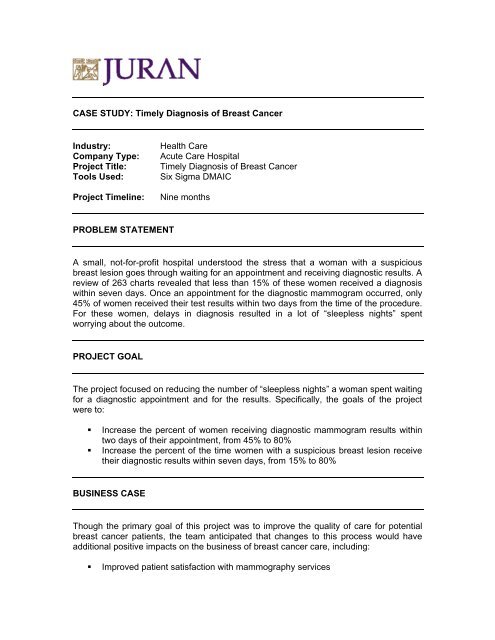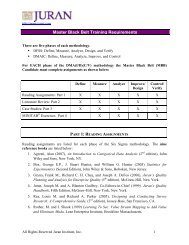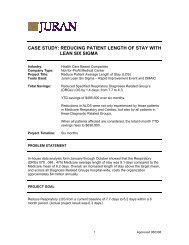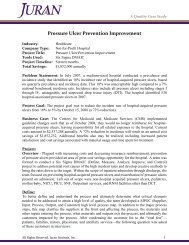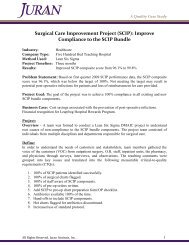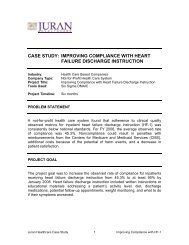Case Study Timely Diagnosis of Breast Cancer.pdf
Case Study Timely Diagnosis of Breast Cancer.pdf
Case Study Timely Diagnosis of Breast Cancer.pdf
You also want an ePaper? Increase the reach of your titles
YUMPU automatically turns print PDFs into web optimized ePapers that Google loves.
CASE STUDY: <strong>Timely</strong> <strong>Diagnosis</strong> <strong>of</strong> <strong>Breast</strong> <strong>Cancer</strong><br />
Industry:<br />
Company Type:<br />
Project Title:<br />
Tools Used:<br />
Project Timeline:<br />
Health Care<br />
Acute Care Hospital<br />
<strong>Timely</strong> <strong>Diagnosis</strong> <strong>of</strong> <strong>Breast</strong> <strong>Cancer</strong><br />
Six Sigma DMAIC<br />
Nine months<br />
PROBLEM STATEMENT<br />
A small, not-for-pr<strong>of</strong>it hospital understood the stress that a woman with a suspicious<br />
breast lesion goes through waiting for an appointment and receiving diagnostic results. A<br />
review <strong>of</strong> 263 charts revealed that less than 15% <strong>of</strong> these women received a diagnosis<br />
within seven days. Once an appointment for the diagnostic mammogram occurred, only<br />
45% <strong>of</strong> women received their test results within two days from the time <strong>of</strong> the procedure.<br />
For these women, delays in diagnosis resulted in a lot <strong>of</strong> “sleepless nights” spent<br />
worrying about the outcome.<br />
PROJECT GOAL<br />
The project focused on reducing the number <strong>of</strong> “sleepless nights” a woman spent waiting<br />
for a diagnostic appointment and for the results. Specifically, the goals <strong>of</strong> the project<br />
were to:<br />
• Increase the percent <strong>of</strong> women receiving diagnostic mammogram results within<br />
two days <strong>of</strong> their appointment, from 45% to 80%<br />
• Increase the percent <strong>of</strong> the time women with a suspicious breast lesion receive<br />
their diagnostic results within seven days, from 15% to 80%<br />
BUSINESS CASE<br />
Though the primary goal <strong>of</strong> this project was to improve the quality <strong>of</strong> care for potential<br />
breast cancer patients, the team anticipated that changes to this process would have<br />
additional positive impacts on the business <strong>of</strong> breast cancer care, including:<br />
• Improved patient satisfaction with mammography services
• Reduced cost per exam through improved scheduling efficiency<br />
• Reduced dollars paid in overtime, which sometimes run high because <strong>of</strong> a<br />
schedule that under-anticipates mammography volume<br />
• Increased diagnostic and surgical volume for breast cases, resulting in increased<br />
revenue<br />
• Adjusted pricing and established pr<strong>of</strong>it margin for digital mammograms, resulting<br />
in increased revenue<br />
PROJECT<br />
Overview<br />
The hospital’s leadership selected a core, multidisciplinary project team to analyze the<br />
reasons for delays in communication <strong>of</strong> the diagnosis and recommend improvements to<br />
reduce the number <strong>of</strong> “sleepless nights.” In addition, the core team identified a support<br />
team to serve as a resource to the project which consisted <strong>of</strong> physicians, diagnostic<br />
imaging staff, transcription, scheduling, finance, and information services.<br />
The project scope included all process steps to diagnose a suspicious breast lesion for<br />
women with a new onset <strong>of</strong> suspicion and for women with a previous incident <strong>of</strong> breast<br />
cancer. This included imaging studies to diagnose a suspicious breast lesion such as<br />
mammogram, ultrasound, radiological biopsy, and surgical biopsy. The communication<br />
processes for these studies, such as all pathology and radiology medical reports,<br />
appointment scheduling, and communication <strong>of</strong> results, was also included. The project<br />
did not include an examination <strong>of</strong> the full radiologist workflow. Situations in which the<br />
diagnostic process was aborted for any reason were not included in the project.<br />
DMAIC Process<br />
The team selected the DMAIC process as its improvement method. A Six Sigma<br />
DMAIC project is defined as a project that eliminates a chronic problem that is causing<br />
patient dissatisfaction, defects, costs <strong>of</strong> poor quality, or other deficiencies in<br />
performance.<br />
Current Process Capability<br />
• Using data from a physician self-report survey (n=38), the hospital determined<br />
that the median number <strong>of</strong> days women waited to hear the results <strong>of</strong> their<br />
diagnostic procedure was three days. The team considered anything over two<br />
days a defect, which generated a short term sigma level for this process <strong>of</strong> 1.37<br />
with a DPMO <strong>of</strong> 552,632.<br />
• Using data from a comprehensive 30-month chart review (October 2004 to April<br />
2007), the hospital outlined its current process capability from the number <strong>of</strong><br />
days a suspicious lesion was identified to results <strong>of</strong> the diagnosis received. The<br />
median was 18 days. The short term sigma level for this process was 0.47 with<br />
DPMO at 847,909.
Voice <strong>of</strong> the Customer<br />
The Voice <strong>of</strong> the Customer is a key tool in a Six Sigma DMAIC project that methodically<br />
determines what will meet and exceed customer expectations. After selecting the key<br />
internal and external customers—patients, physicians, pathologists, surgeons, and the<br />
tumor board—the team employed various methods to gather the voices <strong>of</strong> these<br />
customer groups.<br />
55 women with a breast cancer diagnosis participated in a focus group, telephone<br />
interview, or survey. Their verbatim comments and responses to questions were<br />
translated into the critical-to-quality elements <strong>of</strong> the process:<br />
• An understanding <strong>of</strong> what the diagnostic process will be like with no surprises<br />
• The ability to schedule tests in a timely manner<br />
• A short time interval between the test and the phone call to communicate results<br />
• A short time interval between “suspicion” and diagnosis<br />
.<br />
15 physicians were interviewed, and their comments were translated into their critical-toquality<br />
elements:<br />
• Ability for their patients to get tests scheduled in a timely fashion<br />
• Time interval from “suspicion” to diagnosis should be no more than one week<br />
• Rapid distribution <strong>of</strong> the radiologist’s report<br />
Process Design<br />
The team spent time understanding and analyzing its current process maps. The team<br />
concluded that variability in the process <strong>of</strong> communicating test results (Y 1 ) was specific<br />
to the procedures <strong>of</strong> the individual physician <strong>of</strong>fices. The radiologists read exams and<br />
dictate reports, but do not communicate with patients. This part <strong>of</strong> the process then<br />
depends on the primary care <strong>of</strong>fice receiving the faxed report or looking in the computer<br />
(Meditech) for the results and then calling the patient. The team identified that busy<br />
<strong>of</strong>fice practices <strong>of</strong>ten lose track <strong>of</strong> this step.<br />
The cycle time process (Y 2 ) had several key areas <strong>of</strong> delay that the team was able to<br />
identify through the process mapping exercise. Most <strong>of</strong> the delays were identified in the<br />
system <strong>of</strong> scheduling both mammograms and biopsies. The key issues identified were:<br />
• Scheduling block too long. The basic unit <strong>of</strong> scheduling was 15 minutes.<br />
Screening tests take 20 minutes but would need to be scheduled for two blocks.<br />
Diagnostic tests take 40 minutes and were scheduled for three blocks. With each<br />
exam, there were valuable minutes lost during the day.<br />
• No dedicated appointments for diagnostic mammograms. Schedule times were<br />
not dedicated to either screening or diagnostic tests. Because screening tests<br />
are booked months in advance, those slots filled first, leaving fewer openings for<br />
the short-term needs <strong>of</strong> diagnostic appointments.<br />
• Standard set at 14 days. Scheduling staff was told to book diagnostic<br />
appointments within 14 days before calling to obtain something on shorter notice.
Voice <strong>of</strong> the customer data from patients and physicians indicated a desire for a<br />
two-day turnaround on diagnostic appointment scheduling.<br />
• No confirmation/reminder system. There was no system to confirm screening<br />
appointments which were <strong>of</strong>ten made months in advance. These patients were<br />
no-shows, tying up valuable slots and associated resources more than 11% <strong>of</strong><br />
the time.<br />
• Alignment <strong>of</strong> diagnostic modalities. It was difficult to align the mammogram and<br />
ultra sound modalities since they are in different modules <strong>of</strong> the scheduling<br />
program.<br />
Cause-and-Effect Diagram<br />
The cause-and-effect diagram enabled the team to identify other factors that contributed<br />
to the Y 1 and Y 2 problems. Several additional potential Xs were added to the list<br />
following the cause-and-effect exercise, including:<br />
Y 1 : Communication<br />
• The Bi-Rad letters sometimes presented a confusing message.<br />
• Errors or missing information in transcription can delay the report from being<br />
completed.<br />
• The referring doctor does not always get the order right.<br />
• Not all radiologists read mammograms.<br />
• Emergencies have higher priority.<br />
• Radiologists do not always prioritize mammograms.<br />
• The radiologists have a busy daily schedule filled with interventional procedures.<br />
• Patients are not always home when the call comes.<br />
Y 2 : Cycle Time<br />
• Radiologists do not schedule dedicated mammogram dictation time.<br />
• Biopsy decisions require physician-to-physician communication.<br />
• Referring physician does not always order the right tests.<br />
• Radiologists consider mammograms lower priority for reading.<br />
Vital Few Xs<br />
With sigma levels for both Ys indicating more than a 50% defect rate, the team decided<br />
it was futile to conduct additional statistical analysis on potential variables to determine<br />
root causes. Analysis <strong>of</strong> the process flow diagrams, cause-and-effect diagrams, and<br />
impact/control analysis revealed the root cause without advanced statistical analysis –<br />
there was not a reliable, standardized process for diagnosing breast lesions that met<br />
customer expectations. In order to improve the experience for women with suspicious<br />
breast lesions and reduce the number <strong>of</strong> “sleepless nights” they encountered, the team<br />
would have to create a new process from scratch that met the women’s needs and<br />
ensured the process was capable <strong>of</strong> delivering the expected turnaround and cycle times.
Using these analysis tools, the team zeroed in on a few key breakdowns in the existing<br />
process that would need to be addressed in a new process to reduce the time from<br />
diagnostic exam to results received (Y 1 ). These included:<br />
• The radiologists do not typically devote specific time increments to reading<br />
diagnostic mammograms.<br />
• Referring physicians are not always aware that the test results are available in<br />
Meditech.<br />
• Radiologists do not have time to communicate with patients, so they rely on the<br />
referring physicians to do so.<br />
The team also identified several key breakdowns for the overall process from suspicion<br />
to diagnosis cycle time (Y 2 ). These included:<br />
• The need to align the diagnostic mammogram and ultrasound appointments.<br />
• The need to shorten the 14-day window allowed for scheduling diagnostic<br />
mammograms.<br />
• The need to separate the diagnostic mammogram slots from the screening <strong>of</strong><br />
appointments to ensure enough capacity.<br />
• The need to adjust the 15-minute blocks to 10 minutes.<br />
Implementation and Control<br />
First the team designed a short-term pilot test to guide them in process re-design. They<br />
recruited from the active medical staff and obtained 12 recruits. The team developed<br />
forms for tracking the patients <strong>of</strong> those invited physicians.<br />
The team decided that the new process would consist <strong>of</strong> two key features that provided<br />
solutions to many <strong>of</strong> the root causes. First, the team developed new “if/then” standing<br />
orders that expedited a patient getting a diagnostic mammogram if there was something<br />
suspicious found on the screening mammogram. Second, the team developed a role for<br />
a <strong>Breast</strong> Health Navigator. This person’s sole responsibility was to help steer the patient<br />
quickly through the diagnosis process; providing rapid communication to the patient,<br />
assisting with exam scheduling, and serving as a liaison with the referring physician. The<br />
team captured data from this pilot process for two months.<br />
While the pilot was underway, the team also worked to develop a new patient schedule<br />
based on 10-minute appointment blocks. They used the two previous year’s volume<br />
statistics to approximate the number <strong>of</strong> dedicated diagnostic mammogram slots with the<br />
goal <strong>of</strong> exceeding the demand. During this same time, a new Women’s Imaging Center<br />
was opened. The team continued to track data, troubleshoot issues with the new facility,<br />
and tweak the implementation <strong>of</strong> the two key features.<br />
SUMMARY OF RESULTS<br />
During the pilot phase, the median time from the diagnostic appointment to results<br />
received (Y 1 ) reduced from three days to zero days. In most cases, women received<br />
their results prior to leaving the <strong>of</strong>fice. Also, during the pilot phase, the median cycle time
from suspicion to communication <strong>of</strong> diagnosis, or “sleepless nights” (Y 2 ), was reduced<br />
from 18 days to 9.5 days.<br />
Eleven months following the completion <strong>of</strong> the project, the team’s Y 1 goal <strong>of</strong><br />
communicating test results to patients in less than two days has been sustained. The<br />
median number <strong>of</strong> days remains at zero. 91% <strong>of</strong> all women diagnosed receive their test<br />
results the same day. This is due to the role <strong>of</strong> the <strong>Breast</strong> Health Navigator (RN) who<br />
can act as an extension <strong>of</strong> the physicians in the role <strong>of</strong> communicating directly with<br />
patients.<br />
The team found they were unable to sustain the pilot results for sleepless nights, but<br />
drastic improvements were nonetheless documented. In the 11 months between July<br />
2007 and May 2008, the median sleepless nights held steady at 11.64 days. What is<br />
perhaps more remarkable about this result is how consistent it has been, especially<br />
when compared to the cycle time performance prior to the project. This control chart<br />
shows the improvements in process reliability as a result <strong>of</strong> the project:<br />
Sleepless Nights<br />
Median Days -- from Diagnostic Exam to Pathology Report<br />
40<br />
pre-project<br />
pilot&control<br />
30<br />
Days<br />
20<br />
10<br />
UCL=16.35<br />
_<br />
X=11.64<br />
LCL=6.92<br />
0<br />
OCT 05<br />
JAN 06<br />
APR 06<br />
JUL 06<br />
OCT 06<br />
JAN 07<br />
A PR 07<br />
JUL 07<br />
Month<br />
Oct-05 through May-08 Cost Accounting and PCI chart review<br />
OCT 07<br />
JAN 08<br />
APR 08<br />
Other results outlined in the business case for the project are summarized below:<br />
• Patient Satisfaction: Mean scores for mammography on Press Ganey surveys<br />
increased from 91.2 to 95.1, with an increase in national percentile ranking from<br />
the 17 th to 99 th percentile.<br />
• Cost per Exam: Efficiencies in the new process should reduce the cost per exam.<br />
• Overtime Dollars: For the first six months following the project completion,<br />
overtime costs ran $5,380 as compared to a prior six-month period when<br />
overtime expenses were $12,500.<br />
• Exam Volume: There was no increase in the volume <strong>of</strong> diagnostic mammograms<br />
over the same time period in the previous year. However, there has been a 29%<br />
increase in the volume <strong>of</strong> screening mammograms.<br />
• Pricing: Under the old pricing structure, we showed a net loss <strong>of</strong> $387,454<br />
between October 2006 and May 2007. During that same time period in the<br />
current fiscal year, there was a net gain <strong>of</strong> $47,693. This was due to the pricing<br />
adjustments and volume increases that resulted in the work <strong>of</strong> the project team.
FOR MORE INFORMATION<br />
For information on how we can help your organization attain results, please contact us at<br />
800.338.7726 or visit us on the web at www.juran.com.


